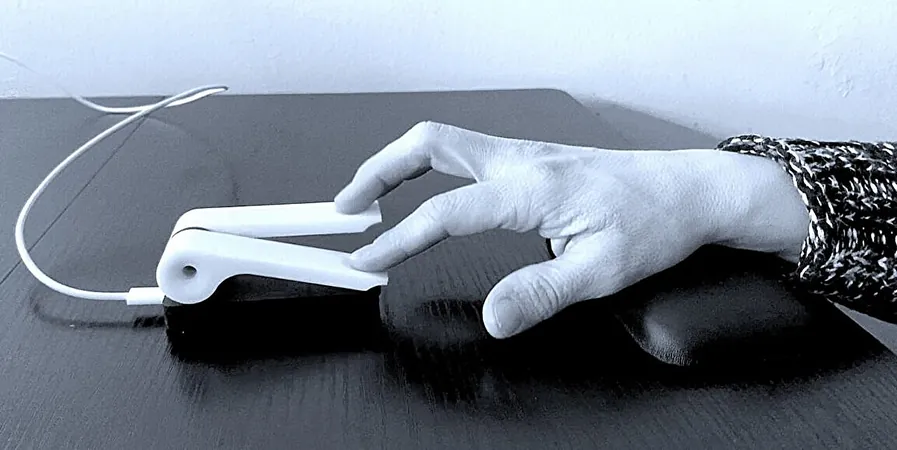
Revolutionary New Device Promises to Transform Parkinson's Disease Care – Here’s How!
2024-09-24
Author: John Tan
Introduction
The rise in Parkinson's disease cases over the last 25 years is alarming, with the global affected population doubling during this period. Yet, despite these growing numbers, methods for treatment and monitoring remain strikingly outdated, often utilizing subjective assessments that fail to adequately capture disease progression. Many patients wait months, or even years, between doctor visits, resulting in confusion about their condition and concerns over medication efficacy.
Groundbreaking Development
In a groundbreaking development, researchers at Stanford Medicine have unveiled an innovative, portable device linked to a smartphone app, crafted to enable patients to quantify their Parkinson's symptoms from the comfort of their homes. This technology promises not only to empower patients but also to furnish healthcare providers with vital data to guide treatment remotely.
Dr. Helen Bronte-Stewart, a prominent figure in neurology and neuroscience at Stanford, spearheaded this project, which revolves around the Quantitative DigitoGraphy Care digital platform and the compact KeyDuo device. With recent funding support from various prestigious institutions, this technology aims to bridge the gap in Parkinson's monitoring.
Tackling the Challenges in Parkinson’s Disease Management
Currently, healthcare providers often rely on in-person physical exams, relying heavily on subjective ratings to assess tremors and movement slowness, known as bradykinesia. Only about 40% of Parkinson's patients consult a neurologist, leading many to self-manage their condition with little professional guidance. The road to obtaining precise, objective measurements has remained challenging, hindering the development of new treatment options.
Dr. Bronte-Stewart highlights a crucial parallel in diabetes care—where continuous glucose monitoring has transformed treatment management. The same revolution is desperately needed for Parkinson's patients, who often await guidance and support beyond their infrequent clinical visits.
The Inspiration Behind the Device
The idea for this tactile measurement tool emerged during Dr. Bronte-Stewart’s work at a clinic for performers dealing with dystonia. An unexpected test with a pianist suffering from Parkinson’s revealed that the device could accurately show the differences in symptom severity based on the musician's medication status. The invention efficiently captures data on how patients press levers, revealing details such as strength, speed, and depth of movement—all critical for effective assessment.
Empowering Patients with Real-Time Monitoring
One of the standout features of the KeyDuo device is its portability, allowing easy usage anytime, anywhere. Accompanied by a mobile application, patients can conduct tests and automatically transmit results to their healthcare providers in real time.
Early results from ongoing research show promising outcomes. In an initial study involving eight patients over 30 days, the device successfully tracked symptom fluctuations, informing treatment adjustments both daily and over weeks. Crucially, recent findings indicate that the device can detect and quantify involuntary tremors, achieving an impressive sensitivity rating of 98%.
Revolutionizing Patient Care and Research
This technological advancement holds the potential to standardize care practices and enhance patient relationships. By providing continuous monitoring data, healthcare providers can make informed decisions remotely, leading to improved medication management and more meaningful patient interactions, even in the absence of regular in-person appointments.
Moreover, the implications for clinical research are profound. The tool may accelerate the evaluation of new Parkinson's therapies, making it easier to recruit participants and lowering study costs by offering precise measurements without the need for frequent clinic visits.
Conclusion
As we navigate this pivotal moment in Parkinson’s disease management, the adoption of such technology underscores the immense potential of modern medical innovation to redefine patient experiences and health outcomes. Could this be the future of neurological care? Stay tuned!


 Brasil (PT)
Brasil (PT)
 Canada (EN)
Canada (EN)
 Chile (ES)
Chile (ES)
 España (ES)
España (ES)
 France (FR)
France (FR)
 Hong Kong (EN)
Hong Kong (EN)
 Italia (IT)
Italia (IT)
 日本 (JA)
日本 (JA)
 Magyarország (HU)
Magyarország (HU)
 Norge (NO)
Norge (NO)
 Polska (PL)
Polska (PL)
 Schweiz (DE)
Schweiz (DE)
 Singapore (EN)
Singapore (EN)
 Sverige (SV)
Sverige (SV)
 Suomi (FI)
Suomi (FI)
 Türkiye (TR)
Türkiye (TR)